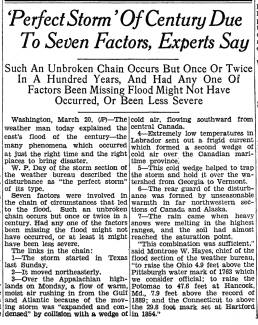Collection Name
About
'Perfect Storm' Of Century Due To Seven Factors, Experts Say
Such An Unbroken Chain Occurs But Once Or Twice In A Hundred Years, And Had Any One Of Factors Been Missing Flood Might Not Have Occurred, Or Been Less Severe
Washington, March 20. —The weather man today explained the east's flood of the century—the many phenomena which occurred at just the right time and the right places to bring disaster.
W. P. Day of the storm section of the weather bureau described the disturbance as "the perfect storm" of its type.
Seven factors were involved in the chain of circumstances that led to the flood. Such an unbroken chain occurs but once or twice in a century. Had any one of the factors been missing the flood might not have occurred, or at least it might have been less severe.
The links in the chain:
1—The storm started in Texas last Sunday.
2—It moved northeasterly.
3—Over the Appalachian highlands on Monday, a flow of warm, moist air rushing in from the Gulf and Atlantic because of the moving storm was "expanded and condensed" by collision with a wedge of from cold air, flowing southward central Canada.
4—Extremely low temperatures in Labrador sent out a frigid current which formed a second wedge of cold air over the Canadian maritime province.
5—This cold wedge helped to trap the storm and hold it over the watershed from Georgia to Vermont.
6—The rear guard of the disturbance was formed by unseasonable warmth in far northwestern sections of Canada and Alaska.
7—The rain came when heavy snows were melting in the highest ranges, and the soil had almost reached the saturation point.
"This combination was sufficient," said Montrose W. Hayes, chief of the flood section of the weather bureau, "to raise the Ohio 4.9 feet above the Pittsburgh water mark of 1763 which we consider official; to raise the Potomac to 47.6 feet at Hancock, Md., 7.9 feet above the record of 1889; and the Connecticut to above the 29.8 foot mark set at Hartford in 1854."
